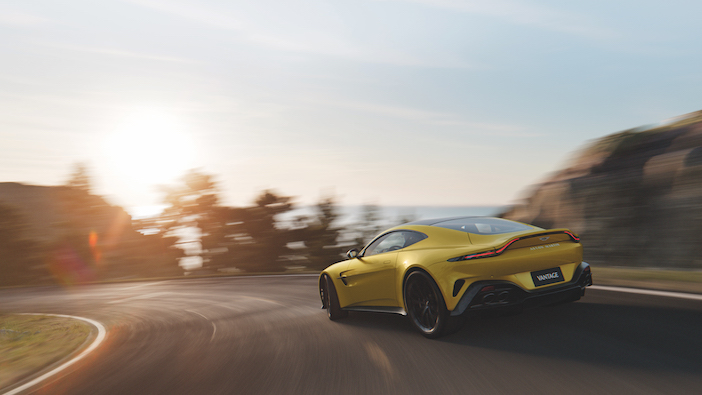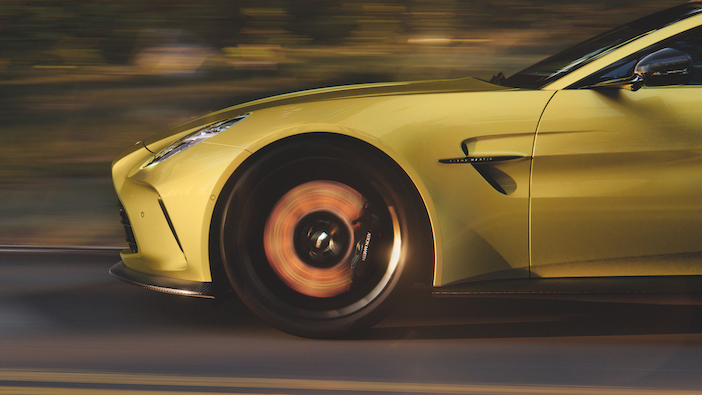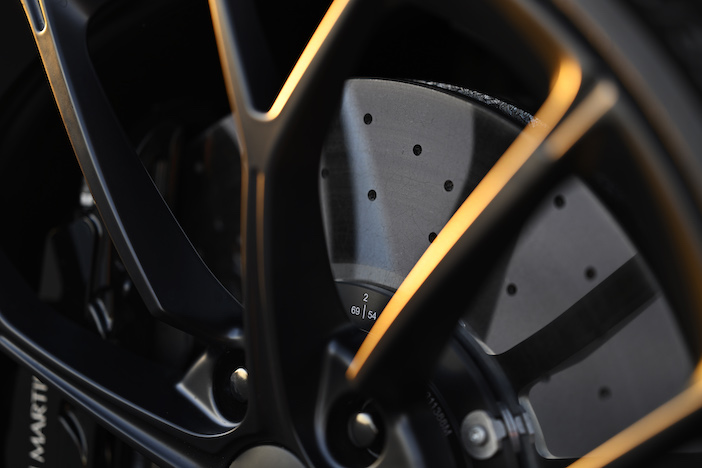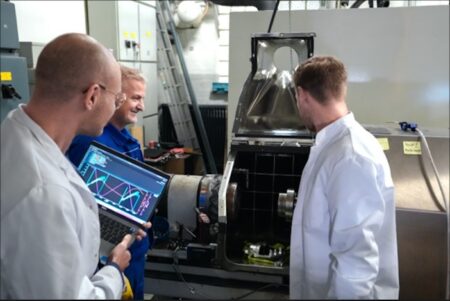Aston Martin has unveiled the latest-generation Vantage, which brings the classic attributes of brute power, precise handling, 50:50 weight distribution and a rear-wheel drive chassis, all wrapped in beautiful bodywork.
The power is provided by a heavily reworked, hand-built 4.0 twin-turbo V8 engine, with 665PS and 800Nm of torque – some 155PS (30%) and 115Nm (15%) more than the previous model. The leap in power has been achieved through extensive tuning work by Aston Martin engineers on the Mercedes-AMG-derived V8 , including modified cam profiles, optimised compression ratios, larger turbos, and increased cooling. The eight-speed ZF automatic transmission translates this work into a top speed of 202mph and a 0-60mph time of 3.4 seconds (with the new launch control system).
The power is impressive, but what of the vehicle dynamics? The 2025MY Vantage is based on Aston Martin’s latest-generation bonded aluminium construction, with an enhanced body structure and additional underbody stiffening components for increased overall torsional rigidity.
Key changes to the structure are a re-engineered and re-positioned front body cross-member, which has been moved rearwards to increase mounting point stiffness for the double-wishbone front suspension, resulting in improved steering feel, both on and off-centre. Further improvements have been achieved with the fitment of a stiffer and lighter front engine cross-brace for increased torsional rigidity and lateral stiffness between the front suspension towers.
At the rear, the new Vantage has a 29% increase in stiffness under cornering load compared to the outgoing model, thanks to increased lateral strengthening between the rear suspension towers. Together with revisions to the front and rear undertrays for greater lateral stiffness, Aston Martin says the combined improvements in front and rear mounting stiffness for the dampers translates to tangible gains in precision, handling balance and driver feedback, together with an ‘overall uplift in refinement’.
New intelligent Bilstein DTX adaptive dampers have been specified, claimed to enable a massive 500% increase in bandwidth of force distribution over the previous-generation hardware, which Aston Martin’s vehicle attributes engineers have exploited to sharpen the Vantage’s dynamics, with progressively tighter body control as the driver moves up the range of dynamic modes.

Active Vehicle Dynamics control
Beyond the sophisticated hardware and setup, the engineering team has ‘intensified’ the Vantage’s handling character with an advanced vehicle dynamics control system. As usual, the system takes information from multiple car and driver sensors such as the six-axis accelerometer, powertrain, braking system and E-Diff sensors, to build a detailed picture of the car’s movement, and then applies that data to the overall management of the ESP system. The ESP takes that information and compares it against model-based Integrated Vehicle Dynamics Estimation (IVE) parameters, so it can then actively control the three key pillars of the vehicle dynamics system – ride, handling and steering – to optimise vehicle response and handling behaviour in all weather conditions, on road and track.
The new-generation active vehicle dynamics control system features a 6D IMU (Inertial Measurement Unit), which combines monitoring of surge (moving forward/backward), heave (moving up/down) and sway (moving left/right) with roll (tilting side-to-side), pitch (tilting forward/backwards) and yaw (turning left/right). The 6D means that the IMU simultaneously tracking the car’s movements and rate of acceleration in all six axes, so the appropriate degree and rate of ESP intervention is applied.
The E-Diff (electronic rear differential) actively augments stability in conjunction with the ESP, and can go from zero to full lock in 135ms, reacting as quickly as 60ms when needed as a vehicle dynamics modifier.

The Integrated Brake Slip Control (IBC) system uses the latest-generation ABS control system for optimised stopping distances, and can apply Brake Slip Vectoring to poise the car for entry into a corner. Integrated Traction Control (ITC) combines management of engine, brake and E-Diff to provide predictive slip control for optimum traction, together with Traction Slip Vectoring for the right amount of traction on corner exit. Another system, Integrated Vehicle Dynamics Control (IVC), acts on the brakes, powertrain and E-Diff to manage the ESP for optimised balance and handling at the limits of driving dynamics, improved dynamic characteristics for all driving styles, and predictive activation for smoother ESP interventions.
Working in harmony with the ESP, the E-Diff adapts its behaviour according to the type of corner, helping the Vantage rotate into tighter turns for sharper front-end response, or to maintain composure through high-speed curves.
Aston Martin has tuned the new ESP to serve as a performance aid, not a performance limiter. For example, the new Vantage features Adjustable Traction Control (ATC). In addition to a choice of Wet, On and Track ESP modes, ATC disables the ESP’s yaw-control function, so there is no off-throttle assistance, but a level of traction control is maintained – the precise amount selected by the driver via the ATC rotary switch.
Once accessed, ATC starts in mid-position ‘5’ as a default, but the driver can incrementally reduce or increase the amount of permitted wheel slip. Stepping down from setting 4 to 1 helps to keep the car more stable on-throttle. Typical use scenarios would be to help manage hot tyres on a track or to aid stability in wet track conditions, but it can also help the driver to build confidence with ESP switched off before they move to the higher slip settings accessed in positions 5-8.
When position 5 is selected, the engine torque is modulated to control slip at a level that helps enable a fast, clean lap. The setting allows oversteer, which then requires driver input. Levels 6-8 allow the driver to increase the wheel slip with the yaw control switched off, thereby reducing on-throttle stability. The modes enable a driver to develop their skills to gradually learn the vehicle behaviour at high slip angles before switching to ‘TC Off’, which gives the driver complete unassisted control of the car.
Steering the Vantage
The dynamics team has put a lot of work into the Vantage’s electronic power assisted steering (EPAS) system. A non-isolated steering column has been specified so that steering inputs from the driver are direct and uncorrupted, while the flow of information from the road is tactile, and granular in detail.
The EPAS has a constant 12.8:1 ratio rack with variable, speed-sensitive assistance and 2.27 turns lock-to-lock. This variable level of assistance is integrated with the Vantage’s dynamic mode programmes, the level of assistance reducing incrementally as the driver works their way towards the most aggressive ‘Track’ mode.
Tyres and wheels
Steering response and front-end grip has been further enhanced by ‘AML’ coded Michelin Pilot Sport S 5 tyres made specifically for the Vantage. Measuring 275/35 R21 (103Y) front and 325/30 R21 (108Y) rear, the tyres feature a bespoke compound and have been tuned by the Aston Martin dynamics team for sharp response, high grip levels and progressive breakaway characteristics.
The tyres are fitted to 21in forged alloy wheels measuring 9.5J front and 11.5J rear. The structure of the wheels has been designed using simulation tools to remove every gram of excess mass without compromising strength.

The 2025 Vantage is fitted as standard with cast-iron 400mm front discs and 360mm rear discs, with drilled faces for improved heat management and fade resistance. The brake booster has been re-tuned compared to the outgoing mode to give the driver greater confidence through a firm and progressive pedal response.
Carbon Ceramic Brakes (CCB) can be specified as an option, offering increased braking performance and reduced brake fade at temperatures of up to 800 °C. The CCB option also saves 27kg in unsprung mass compared to the cast-iron braking system, which in turn improves ride quality and steering response.
Roberto Fedeli, Aston Martin’s chief technical officer, said of the new Vantage: “The art of creating a truly great sports car in 2024 is applying cutting-edge technology in a way that enhances and intensifies the driving experience yet does nothing to remove the driver from the process of driving. Vantage will make headlines for the huge increases in power and torque over the outgoing model, but it’s the vivid way in which it deploys such immense performance that will seduce enthusiasts and purists. With a perfectly balanced front-engined rear-wheel drive chassis aided by industry-leading Active Vehicle Dynamics, it combines outright capability with progression and exploitability. It is the perfect contemporary interpretation of a time-honoured legend”.






